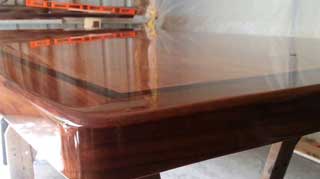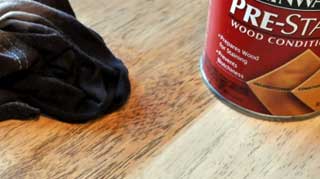One of the biggest challenges while working with wood finishes is to get a mirror finish on the wood. Woodworkers try different methods and techniques to achieve that super gloss finish but only a few get the desired results.
It is understandable because woodworking involves a lot of brushes, machines, and more precisely dust particles. It is however not impossible to achieve a mirror finish on wood despite all these factors.
You can simply do it by yourself. It will just require your complete dedication, attention, and desire to get a glossy finish.
So, do you want that glossy finish?
You have come to the right place. You can find answers to any question that you have regarding your glossy finish in our compiled-up information on how to get a mirror finish on wood. We have also some useful tips to keep your finish clear and shiny for a long period.
Why need a glossy wood finish?
Due to wood nature, it tends to get pale and dull over time. It can lose its charm and shine in it. Paint or bright color can give your wood an attractive look. But a shine in that stain or finish will increase its charm by multiple times and make it stand out among other wooden materials.
No doubt, a gloss level of wood finish will affect how its appearance. Even if you have old wood furniture that is looking dull, you just have to sand it and give it a new finish. It will regain its beauty.
A more mirror-like gloss finish makes a wood stunning. These finishes give vibes of wood being alive. To get that look to follow our guidelines accordingly.
How to get a mirror finish on wood: Step by step guideline
'French Polishing' is the most famous technique used for giving a mirror finish on the wood. However, due to the stickiness of shellac, that process can be time-consuming. The best alternative method on how to get a high gloss finish on the wood is by using a varnish or lacquer.
You can easily spray lacquer but if you are using a varnish then you have a choice between both brushing and spraying. Though, you will be more comfortable with spraying as it takes less time and is an easy job.
However, if you want to give your wood a vibrant glossy look with stain, choose a stain that is super glossed. Apply it after filling grains. Always choose a filler according to the stain you are going to apply. Wear a respirator and start this project.
1. Sand the Curves
If you were unable to do a procedure entirely for the first time, don't hesitate to give it another shot. The best professional outcome results from dedicated work and experience. However, our authentic and complete information makes us confident to get you a high gloss finish on the wood.
For sanding purposes, start it as smooth as possible. Use an electric sander to sand wood for the flat and even surface. Do it by hand where an electric sander cannot reach. As you do it by hand, treat all the parts equally.
Apply the same progression of sandpaper grits and start with 80-grit. After sanding away all the blemishes on wood, use 120-grit and then finally 180-grit. You can choose different grits depending on your work progress for finer cuts.
Always work in the direction of the wood grain. Scratches are hard to see if they are parallel to surface while doing a hand sanding. But they become visible after staining. Sand it until you get a very flat and even surface.
As you do sand with an electric sander, move it on 1 inch per second with slight pressure.
Clean wood for any dirt nibs with a dry cloth.
2. Grain Filler
Maybe you are working on woods like walnut, koa, mahogany, etc. These woods have large pores and surface doesn't get even after sanding. To fill these pores, use a grain filler. A grain filler is a product used for specifically filling these huge pores of the wood to get a high gloss finish.
Grain filler consists of three products; a binder, a solvent, and a bulking agent. Both oil-based and water-based fillers contain silica as a bulking agent and mineral spirits or water as a solvent. You can choose either a water-based filler or an oil-based filler depending on which type of finish you want.
Take a paintbrush and scrub filler into the wood pores. Wipe off extra material immediately. If you have applied filler excessively into grains, hold an old credit card at the right angle to grain and clean filler by pulling it in the direction of the grain.
Clean it carefully. The only purpose is to keep grain filler into the wood pore.
Leave it to dry overnight and then sand it again by using a 220 or suitable grit sandpaper. If you haven't bought a filler already. Don't replace it with a finish.
Because you don't want to see your wood shrinking over time. A finish in wood pores will make wood to contract and these giant pores will again appear.
3. Apply Lacquer or Varnish
You should be aware of how much quantity of lacquer you want to apply. Maintain that specific quantity for each coat. It will give a much smoother mirror-like finish. Apply the first coat of lacquer with a brush or a sprayer. Wait for it to dry.
A lacquer coat usually dries within 15-20 minutes. The best approach is to leave it to dry for at least 30 minutes. If you are using varnish instead of lacquer, then leave it for 3 hours. Lacquer dries fast and varnish takes time.
After making sure that lacquer has completely dried, sand the surface to remove any bumps. Use 320-grit sandpaper first. Clean the dust with a rag. Examine your work under light and see if there is any flaw or imperfection. Do the proper sanding for a smoother result.
Apply two more coats of lacquer. For varnish, apply a single coat. While applying two coats of lacquer sand in between each one. Now allow lacquer or varnish to dry for at least 1 day. Sand again by using a finer grit like 400 grit sandpaper.
For lacquer apply 3 more coats and for varnish apply one coat. Never forget to sand each layer of lacquer before applying another. Use the same sandpaper. At this time allow them to fully heal before further proceeding. Lacquer takes about a week to cure while varnish takes two weeks.
4. Wet-Sanding

Wet sanding is very important to give a clean crystal finish to your wood. This ensures a flat surface by removing any minor scratches that are left behind. Take a silicon carbide sandpaper and use water as a lubricant. Do wet sanding by using 400-grit sandpaper.
Gently sand the whole surface. Now use 600-grit sandpaper on for 2nd wet sanding. Now rub 800-grit sandpaper on it. Keep repeating the wet sanding on the surface until you feel that there is no rough spot left on the wood.
It is easy to do wet sanding in a circular motion. However, it is best to do sanding in the direction of wood grains.
5. Buffing
Rubbing compounds are used to level the surface and are also known as level compounds. It works by leveling the different stretches of different depths. Polishing compounds are famous to leave a shiny surface. It doesn't smooth down any scratches.
Apply to rub compound with a low-speed automotive buffer. However, you can also use a rubbing compound by hand. Choose a rubbing compound before polishing. If you have perfectly flattened the surface through sanding, you can skip this rubbing procedure and directly apply a polish.
Rub on the surface evenly. You can use a cloth or old t-shirt for this purpose. Start by applying a small amount of rubbing compound on the cloth. Now clean all the surfaces properly and switch to the polishing compound.
Polishing can be done by any kind of polishing compound but a more common way to do it is by using pumice and rottenstone. Sprinkle water on the surface with a polishing compound. Start buffing the surface using an electric buffer or a sponge pad.
Even when you are using any machine to buff the surface, always finish it by hand buffing using a cotton rag. For both polishing and rubbing, prefer a power buffer. Power buffer will give you a glossier finish.
Tips and technique of keeping wood glossy for a long time
Get a clear high gloss appearance on your next finishing project for a long time with the help of the below-mentioned tips.
1. Sand like a pro
With the help of the above-mentioned method, you will be able to sand professionally. Always try to use suitable sand grits for your wood. After sanding one time, switch to a finer sand grit. Do sanding in the direction of wood grain and not in circular motions.
When your power sander isn't reaching to a particular area, sand that portion with hand and don't skip it. No doubt sanding is the key feature to get a clear glossy finish. After sanding, examine every inch of wood to see a rough patch. Where a wood still seems rough, sand that part again.
While examining, shine the light at a low angle on the surface. This will help in revealing all imperfections and flaws. You can also mark that exact area where sanding is again needed with the help of masking tape.
2. Some mistakes are okay
After applying varnish, lacquer, or any other stain and completing the process, just leave any mistakes alone. If you have noticed a small spot of stain that isn't looking smooth or any other minor problem, it is not your fault. Don't try to even out that spot.
Chances are that those spots can be still sticky and you will end up damaging them more. Cause of these spots can be minor things like a little pitiful fly trapped in you finish. However, if you are still bothered by that spot, you can try a few things.
Instead of brushing and over-coating, simply pluck out that fly, hair, or any other bristle. While doing this, keep your hand still. If there are tiny bubbles. pop them out with a small pin.
3. The better brush is the solution
It doesn't matter what type of wood finish you are applying on your wood, always choose a brush that is intended to apply that specific stain. The best way to apply the polyurethane-based stain is through the brush. Select a synthetic brush for it. For oil-based stains, prefer a natural coat brush.
Always choose a quality brush if you want that high gloss looks on your wood. A quality brush will be able to hold more stain and will be easy to handle. It is very less likely for a good brush to leave any marks or bristles behind.
Always wash and clean your brushes thoroughly because they will save you from investing money on more brushes in the future.
4. Use Wood Conditioner
If you are applying a super gloss stain or any other finish, use a wood conditioner. A wood conditioner will endure the evenness and mirror look of finish. Sometimes due to uneven distribution of stain, some patches appear dark or light.

You can minimize these light and dark spots by applying a wood conditioner before staining. Especially, if you are high glossing wood like maple, cherry, birch, etc.
These woods can play different tricks of having ugly darker spots. It is not possible to finish that effect but you can still avoid it with the help of a wood conditioner.
5. Safety Issues
Before using any power tool for your finishing project, always read the guideline on how to use. Follow all the instructions for using that tool. Be careful with safety warnings and cautions. Keep in mind that following these instructions can save you from a bid accident or injury.
Keep the right safety attitude and don't put everyone around you in danger. While working with finishing, keep yourself clean from any material. Wash your hands properly. Wear gloves and a respirator. Work in a ventilated area and avoid working near any heat source.
While using electric equipment, make sure that you have switched off after using it. An unexpected start of the machine can result in a great dangerous situation.
If something unusual like this happens, don't panic and turn off your machine immediately. Be aware of any odor that can indicate over-heating if machine.
Conclusion
Get a silky-smooth finish on your wood by simply following our steps on how to get a mirror finish on wood. Important things to always remember is doing every procedure correctly and to not skip any step. Every step is vital and is a must to give your wood a smoother touch.
- How to Choose Wood Filament: A Complete Guide - July 17, 2021
- 10 Best Propane Forge Reviews - June 30, 2021
- Best Circular Saw Blade for Plywood : Top 10 Picks - June 30, 2021



Hi, I was curious as to what type of wood stains this applies to. I read that gel-based stains don’t need to be sanded, but would the remainder of your steps work? Would you suggest a gel stain, if not what would you suggest for a novice.
For reference, I am painting a set of doors.
Thank you so much in advance!
You can use gel-based stains. But you need to keep it in mind that as you cannot sand it.
You have to be careful.
All of these comments and instructions apply to wood used inside. Are there instructions available to achieve this same affect on wood that is to be used outside?
You can achieve the same effect on exterior wood with the above steps.